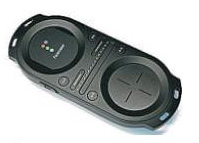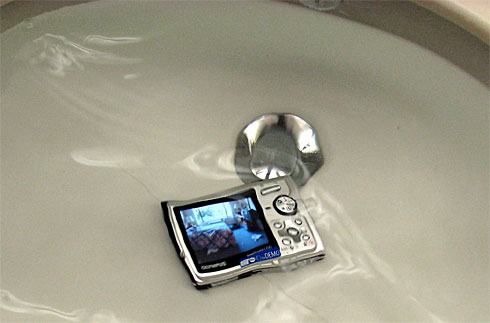Jefferson Graham
USA Today

Michael Shean, left, and Ted Morgan, with their iPhones, got a boost last week when Apple CEO Steve Jobs called their company’s location technology “really cool.”
SAN FRANCISCO — The big idea came on a trip: Ted Morgan and Michael Shean used Wi-Fi signals in their travels so often to pick up e-mail, they saw a business opportunity in their future.
What if they could figure out locations and directions via Wi-Fi signals instead of the more commonly used Global Positioning System (GPS)?
After discovering that it could work, they left their jobs at e-billing company eDocs and formed Skyhook Wireless in 2003. The Boston-based firm raised $16.8 million and signed up several partners to showcase the technology, including AOL and mapping firm Navteq.
Last week, Skyhook was thrust to center stage courtesy of Apple CEO Steve Jobs. He not only demonstrated Skyhook at the Macworld conference here, but also gave a detailed and spirited explanation of how the technology works. “Isn’t that cool?” Jobs said. “It’s really cool.”
Now, users of the iPhone and the iPod Touch (an iPod that can pick up Wi-Fi signals) can find their location and, in conjunction with mapping information from Google, get instant directions. The feature is part of a software update that is free for the iPhone and $20 for current Touch owners.
The alliance and plug from Apple are “enormous for us,” Skyhook CEO Morgan says. “It’s a huge endorsement of the technology.”
Morgan won’t discuss terms but says Skyhook generally gets a royalty on each device sold, similar to how GPS tech companies work with device manufacturers.
USA TODAY caught up with Morgan and Shean during their Macworld visit. During our time together, we drove around the city to see if the iPhone really could tell we were near the Golden Gate Bridge, at Fisherman’s Wharf or cruising down zig-zaggy Lombard Street.
No wrong turns: Skyhook worked as advertised.
Morgan explained how the technology works: “Every Wi-Fi access point, whether public or private, sends out a signal every second or so, like a lighthouse. We pick up those signals and use our technology to calculate your exact location.”
What Skyhook does not do, Skyhook Vice President Shean says, is connect to those Wi-Fi networks. “We’re detecting, not connecting.”
To get the system up and running, Skyhook sent teams of drivers around the USA and Canada to map out hot spots; it now has 70% of North America covered. Skyhook vehicles now are cruising Europe and Asia to add to the database.
Skyhook’s system works best indoors and in urban settings, Morgan says, while GPS is better in areas with clear views of the open skies, to reach satellite signals. He believes device manufacturers will eventually use GPS and Wi-Fi together to serve customers.
Skyhook isn’t the only company touting GPS alternatives.
Google introduced its free “My Location” technology in late November, picking up its information from cellphone towers. Google’s offering works on a handful of Motorola (MOT) and Sony Ericsson phones, smartphones from BlackBerry and “most” Windows Mobile devices, Google says.
Apple uses both Skyhook and Google technology on the iPhone. It looks for Wi-Fi signals first, and if there are none, it switches to Google’s cell-tower information.
Targeting the mobile consumer
According to market tracker Strategy Analytics there will be 4.1 billion mobile phone subscribers by 2010, up from 3.1 billion in 2007.
Charles Golvin, an analyst at Forrester Research, says many phones sold by Verizon, Sprint, AT&T and T-Mobile have some form of location information available, usually for an extra monthly fee.
With the iPhone deal behind him, Morgan’s goal for 2008 is to get other handset manufacturers to use his Wi-Fi technology, as a less expensive and what he deems more reliable alternative to GPS.
He’ll have a much easier time pulling this off than before, Golvin says.
“Getting the credibility associated with not just a well-liked company (Apple), but one with such huge visibility, is very significant,” he says. “And then to be associated with the iPhone as well makes it really extra special.”
Greg Sterling, an analyst at Sterling Market Intelligence, sees the real potential of Skyhook’s instant-location technology in advertising.
The mobile consumer, he says, “is typically closer to a purchase than somebody sitting behind a desk.”
Marketers, he adds, “can figure out where the consumer is, and that makes it that much easier to sell them something. The advertising is directed to you.”
For the future, Morgan says, he wants to go beyond the phone and get Skyhook’s software on laptops and gaming and music devices: “every Wi-Fi-enabled device.”
A handful of music devices and cameras currently have Wi-Fi capability; most don’t. Morgan envisions his technology helping folks “geotag” photos (identify shots from trips to Florida and Canada as an organizational timesaver) and sync songs as a way of eliminating wires.
“You’re not going to buy these devices in the future if it doesn’t have directions or local services to it,” he says. “This is a huge opportunity for us.”











